Transforming your dining room into a stylish and inviting space begins with the right flooring. The choice of flooring not only sets the tone for your dining experience but also enhances the overall aesthetic of your home.
From the warmth of hardwood to the sleek elegance of tile, the options are endless and cater to various tastes and lifestyles. In this blog post, we’ll explore a variety of dining room flooring ideas that blend functionality with beauty.
Whether you’re looking for durability to withstand family gatherings or a luxurious finish for entertaining guests, we’ve got you covered.
Join us as we delve into the latest trends, practical tips, and expert recommendations to help you choose the perfect flooring for your dining area. Ready to elevate your dining room? Read the full blog post to discover the ideal flooring solutions that will make every meal a memorable occasion!
15 Creative Dining Room Flooring Ideas
Classic and Timeless Options
1. Hardwood Flooring
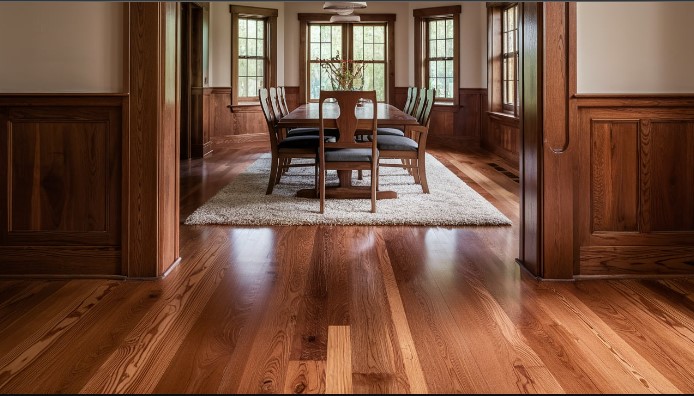
Hardwood floors are a timeless choice for dining rooms, offering unparalleled warmth, beauty, and durability. Popular species like oak, maple, and cherry add natural character and elegance to your dining space, with each wood type showcasing its own unique grain patterns and color variations.
One of the key advantages of hardwood flooring is its longevity. With proper care and maintenance, hardwood floors can last for decades, even in high-traffic areas like the dining room. They are also easy to clean and maintain, making them a practical choice for busy families.
Another benefit of hardwood is its ability to be refinished multiple times, allowing you to change the look of your dining room by sanding and staining the floors as needed. This makes hardwood a versatile and long-lasting investment for your home.
2. Engineered Hardwood
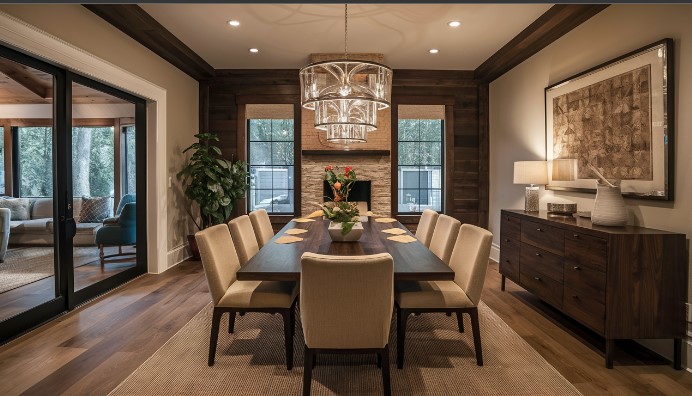
Engineered hardwood flooring offers the best of both worlds – the timeless elegance of real wood combined with improved stability and moisture resistance. This makes it an excellent choice for high-traffic areas in the dining room, where spills and heavy foot traffic are common.
Engineered hardwood consists of a top layer of solid wood, typically oak, maple, or hickory, bonded to multiple layers of plywood or high-density fiberboard.
This construction allows for greater dimensional stability, reducing the risk of warping, cupping, or gapping that can occur with solid hardwood in areas with fluctuating humidity levels.
One of the key advantages of engineered hardwood is its versatility in installation. Unlike solid hardwood, which requires a wooden subfloor, engineered planks can be installed over concrete or existing floors, making it a suitable choice for a wide range of dining room settings.
With proper preparation and installation techniques, engineered hardwood can provide a durable and visually stunning foundation for your dining room decor.
3. Laminate Flooring
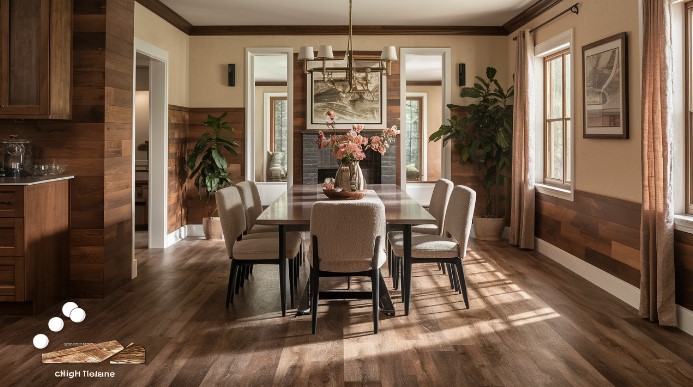
Laminate flooring is an excellent choice for dining rooms, offering a stylish and budget-friendly alternative to traditional hardwood or tile. One of its standout features is its ability to mimic the appearance of natural materials, providing the elegance of wood or the sleekness of tile without the hefty price tag.
Durability and Maintenance
Laminate is designed to withstand the wear and tear of daily life. Its scratch-resistant surface is particularly beneficial in busy dining areas where spills and foot traffic are common. Additionally, laminate is resistant to fading from sunlight, ensuring that your flooring maintains its vibrant appearance over time.
Easy Installation and Variety
Another advantage is the ease of installation. Many laminate options come with a click-lock design, allowing for quick and straightforward setup. With a wide range of colors, patterns, and finishes available, you can easily find a style that complements your dining room decor, making it a versatile and practical flooring solution.
Modern and Stylish Choices
4. Luxury Vinyl Plank (LVP)
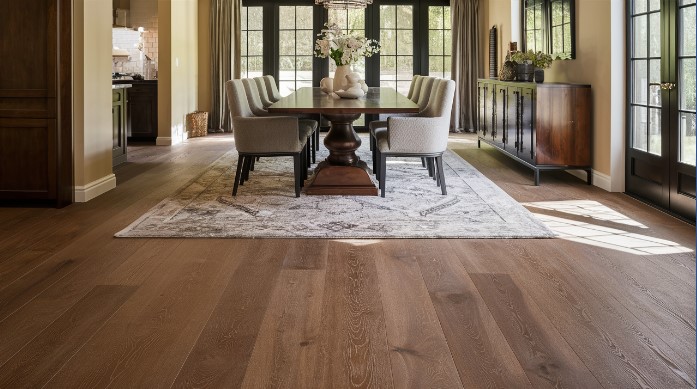
Luxury Vinyl Plank (LVP) is an increasingly popular flooring choice for dining rooms due to its blend of aesthetic appeal and practical benefits. Designed to mimic the look of hardwood, LVP offers a sophisticated appearance while being significantly more durable and water-resistant.
This makes it an ideal option for dining areas where spills and heavy foot traffic are common. LVP is easy to clean, requiring only regular sweeping and occasional mopping, which is a considerable advantage for busy households.
Available in a wide variety of styles, colors, and textures, it can complement both casual and formal dining room designs. Moreover, modern LVP products often feature advanced technologies such as embossed textures and rigid cores, enhancing their realism and comfort underfoot.
With these attributes, LVP not only elevates the visual appeal of a dining room but also provides a resilient flooring solution that stands up to everyday challenges
5. Vinyl Tile
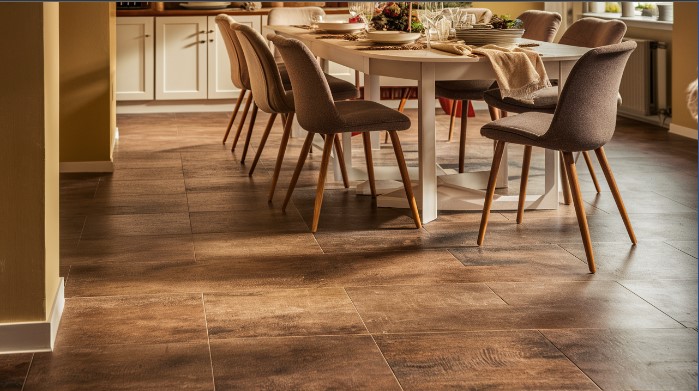
Vinyl tile is an excellent flooring option for dining rooms, combining style, practicality, and durability. One of its standout features is its versatility; vinyl tiles can convincingly mimic the appearance of natural stone, ceramic, or even hardwood, allowing you to achieve the desired aesthetic without the associated costs and maintenance.
Easy Installation and Maintenance
Vinyl tiles are user-friendly when it comes to installation. Many products come with peel-and-stick backing or interlocking designs, making them ideal for DIY enthusiasts. Additionally, they are resistant to stains and moisture, which is particularly beneficial in dining areas where spills are common.
Comfort and Noise Reduction
Vinyl tiles also provide a softer underfoot feel compared to harder materials, enhancing comfort during long meals. Furthermore, they help reduce noise, creating a more pleasant dining atmosphere.
6. Sheet Vinyl
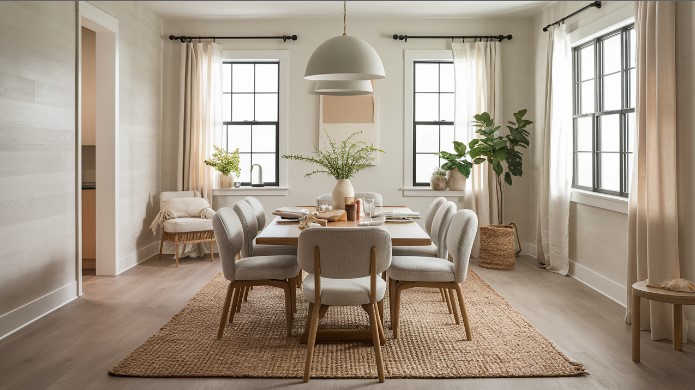
Sheet vinyl is an excellent choice for dining room flooring, particularly in informal settings. One of its standout features is its seamless design, which effectively prevents dirt and moisture from accumulating in grout lines, making it easier to maintain cleanliness.
This is especially beneficial in dining areas where spills are common. Additionally, sheet vinyl comes in a wide array of designs, colors, and textures, allowing homeowners to achieve the desired aesthetic—whether it mimics the look of hardwood, stone, or tile.
Its resilience and comfort underfoot make it a practical option for families and those who enjoy hosting gatherings. Moreover, sheet vinyl is generally more cost-effective than other flooring materials, making it a budget-friendly choice without compromising style.
With its combination of durability, ease of maintenance, and design versatility, sheet vinyl is a smart flooring solution for any dining room.
Elegant and Sophisticated Options
7. Ceramic Tile
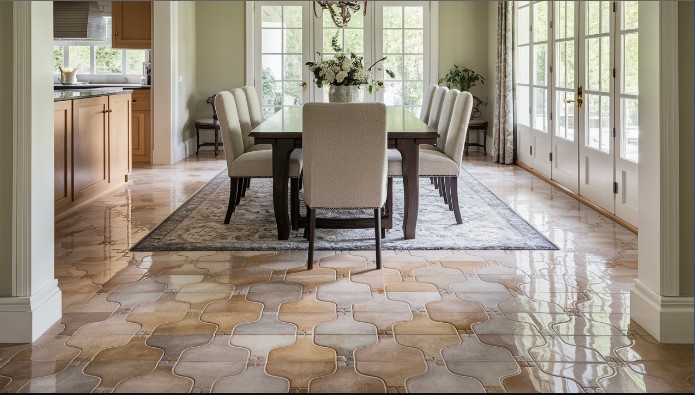
Ceramic tiles are a popular choice for dining room flooring due to their durability, easy maintenance, and versatility. These tiles come in a wide range of colors, patterns, and sizes, allowing you to create a unique and visually appealing design that complements your dining room’s decor.
Ceramic tiles are also highly resistant to moisture, making them an ideal option for areas that may be exposed to spills or high traffic. Additionally, they are easy to clean, requiring only a damp mop or cloth to maintain their pristine appearance.
With proper installation and sealing, ceramic tiles can provide a long-lasting and low-maintenance flooring solution for your dining room.
8. Porcelain Tile
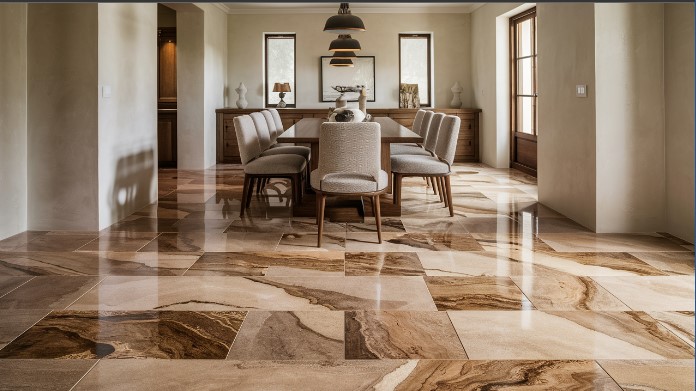
Porcelain is an excellent choice for dining room flooring due to its durability and versatility. It is denser and more resistant to wear and tear compared to ceramic tiles, making it ideal for high-traffic areas like dining rooms.
Porcelain tiles come in a wide range of styles, colors, and patterns, allowing you to create a unique and visually appealing look that complements your dining room’s decor.
One of the key advantages of porcelain tiles is their ability to mimic the appearance of natural stone, such as marble or granite, without the high cost or maintenance requirements. Additionally, porcelain tiles are easy to clean and maintain, ensuring a clean and hygienic surface for your dining area.
9. Natural Stone
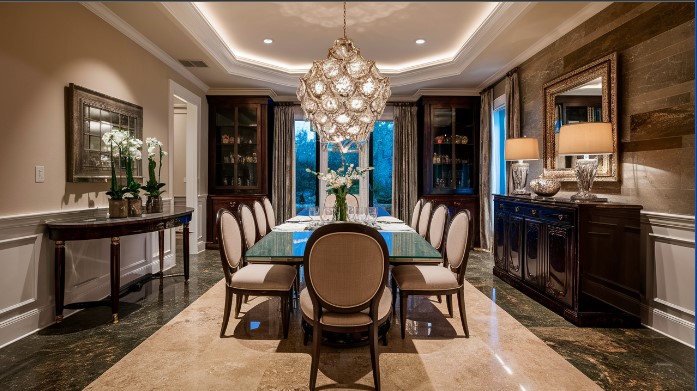
Natural stone flooring, such as slate, marble, or granite, can transform your dining room into a luxurious space. Each type of stone offers unique characteristics that enhance the aesthetic appeal of your home.
Slate
Slate provides a rustic charm with its textured surface and rich color variations. It’s durable and resistant to scratches, making it ideal for high-traffic areas.
Marble
Marble exudes elegance with its stunning veining and polished finish. While it requires regular maintenance to prevent stains and scratches, its timeless beauty can elevate any dining experience.
Granite
Granite is another excellent choice, known for its strength and heat resistance. Available in a variety of colors and patterns, it can complement any decor style.
While natural stone flooring tends to be more expensive upfront, its longevity and unique appearance make it a worthwhile investment. With proper care, these materials can last for decades, adding value and sophistication to your dining room.
Cozy and Comfortable Choices
10. Carpet

Carpet is an excellent choice for dining room flooring, offering a warm and inviting atmosphere that enhances the overall dining experience.
When selecting carpet for this space, consider low-pile options, which are not only easier to clean but also more resistant to wear and tear from heavy foot traffic. Stain-resistant carpets are particularly beneficial in dining areas, as they can handle spills from food and drinks without compromising the aesthetic.
Additionally, carpet provides acoustic benefits, helping to absorb sound and reduce noise levels, creating a more intimate dining environment. To maintain the beauty and functionality of carpet in your dining room, regular cleaning and maintenance are essential.
Choose colors and patterns that complement your decor while also being practical for everyday use. With the right selection, carpet can transform your dining room into a cozy and stylish space.
11. Area Rugs
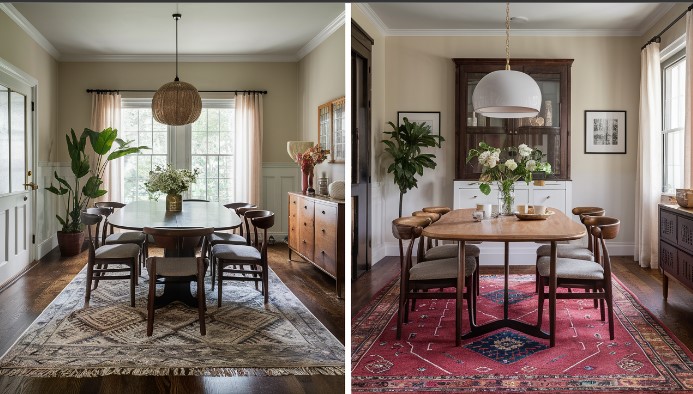
Area rugs are a versatile and practical solution for adding comfort and style to your dining room with hard flooring.
They can define the dining space and create a cozy atmosphere, while also being easy to clean. When choosing an area rug for your dining room, consider the size of the room and the table, as well as the color and pattern that will complement your existing decor.
A larger rug that extends beyond the table legs can help to anchor the space, while a smaller rug can be used to define a specific seating area.
Wool or synthetic area rugs are durable and easy to clean, making them a great choice for high-traffic areas like the dining room. With so many options available, you can find an area rug that perfectly suits your style and needs.
Unique and Eco-Friendly Options
12. Bamboo Flooring
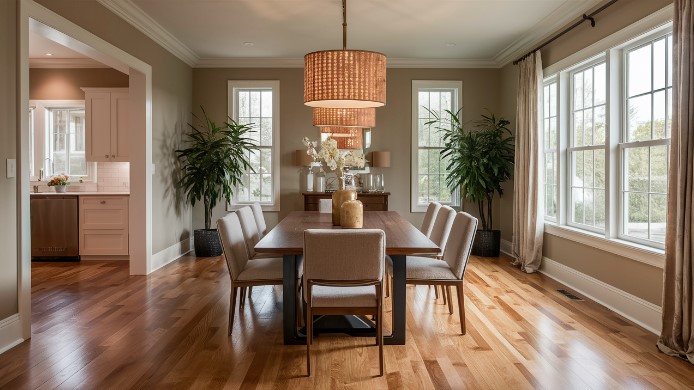
Bamboo is an excellent choice for dining room flooring due to its durability, moisture resistance, and unique aesthetic appeal. As a sustainable material, bamboo offers an eco-friendly alternative to traditional hardwood floors.
Bamboo’s natural beauty can seamlessly integrate with various decor styles, from contemporary to traditional. Its warm tones and distinctive grain patterns add character and visual interest to the dining space.
Strand-woven bamboo is particularly well-suited for dining rooms, as it is highly resistant to scratches, dents, and wear caused by heavy foot traffic and furniture movement. This makes it an ideal choice for families with children or those who frequently entertain guests.
Additionally, bamboo’s moisture resistance makes it suitable for dining rooms, where spills and stains are common occurrences. With proper care and maintenance, bamboo floors can maintain their beauty for years to come, making them a smart investment for any dining room.
13. Cork Flooring

Cork flooring is an excellent choice for dining rooms due to its unique combination of benefits. As an eco-friendly material, cork is harvested from the bark of cork oak trees without harming the trees, making it a sustainable option.
Comfort and Insulation
One of the standout features of cork is its comfort underfoot. The natural cushioning it provides makes standing for long periods more enjoyable, ideal for hosting gatherings. Additionally, cork has excellent thermal insulation properties, helping to maintain a comfortable temperature in your dining area throughout the year.
Mold and Mildew Resistance
Cork is naturally resistant to mold and mildew, which is particularly advantageous in dining spaces where spills and humidity can occur. This resistance contributes to a healthier indoor environment, making it a practical choice for families and those with allergies.
Aesthetic Appeal
Available in various colors and patterns, cork flooring can complement any dining room decor, adding warmth and style to your home. Overall, cork flooring combines functionality with aesthetic appeal, making it a smart choice for your dining area.
Creative and Trendy Ideas
14. Painted or Stained Concrete
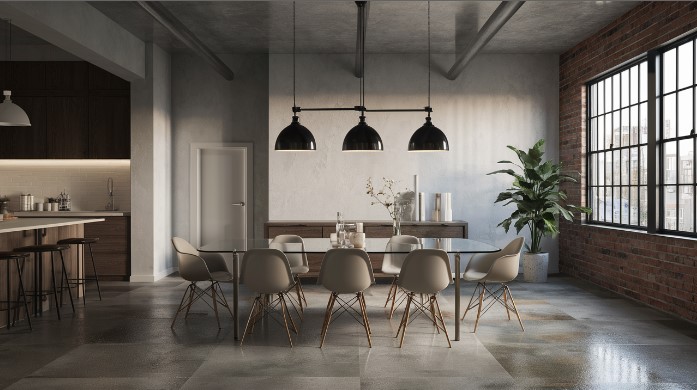
If you’re aiming for a modern and industrial vibe in your dining room, painted or stained concrete is an excellent choice. This flooring option is not only durable but also incredibly easy to maintain, making it perfect for high-traffic areas.
Customization
One of the standout features of concrete is its versatility. You can customize the color and finish to match your decor, whether you prefer a sleek, glossy look or a more rustic, matte finish. Stains can enhance the natural texture of the concrete, creating a unique and visually appealing surface.
Benefits
In addition to its aesthetic appeal, painted or stained concrete is resistant to spills and stains, making cleanup a breeze. It also provides a solid foundation that can help regulate indoor temperatures, contributing to energy efficiency. Overall, painted or stained concrete offers a stylish and practical solution for your dining room flooring needs.
15. Terrazzo Flooring

Terrazzo flooring is an excellent choice for dining rooms, offering a unique and artistic look that sets your space apart. This durable flooring option is made from a blend of marble chips, glass, and other materials, which are then bonded together with a resin or cement matrix.
One of the key advantages of terrazzo is its customizability. You can choose from a wide range of colors and patterns to perfectly complement your dining room’s decor.
Whether you prefer a classic monochrome look or a vibrant, multicolored design, terrazzo can be tailored to your preferences. Terrazzo is also highly durable and low-maintenance, making it ideal for high-traffic areas like dining rooms.
Its smooth surface is easy to clean and resistant to stains, scratches, and wear, ensuring your floors look great for years to come. With its distinctive appearance and practical benefits, terrazzo is a standout choice for creating a memorable and inviting dining room atmosphere.
Benefits of Dining Room Flooring
Enhances Aesthetics The flooring sets the tone for the entire dining room, complementing the decor and creating a cohesive, visually appealing space.
Adds Value to Your Home Durable, well-chosen flooring like hardwood or luxury vinyl plank can increase the value of your home.
Provides Comfort Certain flooring options like carpet offer warmth and comfort underfoot for long dining gatherings.
Withstands Wear and Tear Dining rooms see heavy foot traffic and potential spills, so durable, easy-to-clean flooring is essential.
Offers Design Flexibility With so many flooring types and styles available, you can find an option to suit any design preference.
Requires Low Maintenance Floors like luxury vinyl and laminate are simple to clean and maintain, even in busy dining areas.
Complements Underfloor Heating Engineered wood and luxury vinyl plank work well with underfloor heating systems in dining rooms.
Provides Acoustic Insulation Certain flooring options like carpet can help dampen sound for a quieter, more intimate dining experience.
Conclusion
Selecting the right flooring for your dining room is pivotal in creating a stylish and inviting space. From the warmth and elegance of hardwood floors to the modern appeal of polished concrete or the classic charm of patterned tiles, each option offers unique benefits that can enhance the overall ambiance of the room.
When choosing flooring, consider not only the aesthetic appeal but also the practical aspects such as durability, ease of maintenance, and comfort. Integrating elements like rugs can add texture and warmth, making the dining area feel more cohesive and comfortable.
Ultimately, the best flooring choice will reflect your personal style while complementing the rest of your home’s decor. By thoughtfully combining beauty with functionality, you can ensure that your dining room remains both stylish and inviting for years to come.

